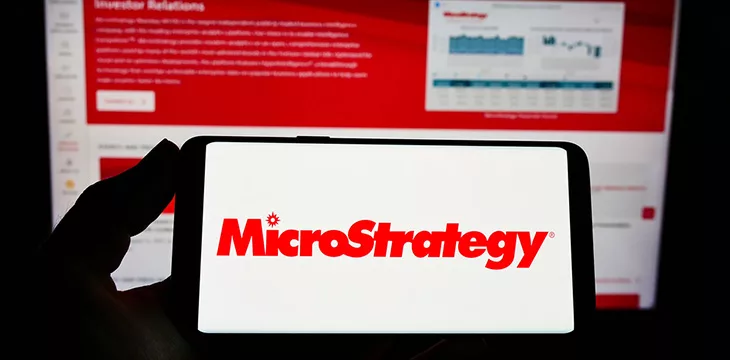|
Getting your Trinity Audio player ready...
|
MicroStrategy (NASDAQ: MSTR) turned its first quarterly profit in two years, partly thanks to a bank failure that helped mask further losses from its ill-advised BTC hoarding strategy.
On Monday, MicroStrategy announced that it generated revenue of $121.9 million in the first three months of 2023, a 2.2% rise from the same period last year. However, the company booked an operating loss of $20.3 million, although the recent increase in the fiat value of the BTC token made that result better than Q1 2022’s $170 million loss.
The company reported a pre-tax profit of $8 million versus a nearly $179 million loss in Q1 22, but this was aided by a one-time $44.7 million gain on debt extinguishment. This debt was owed to now-defunct Silvergate Bank (NASDAQ: SI), which lent MicroStrategy $205 million in exchange for the company putting up nearly 35k BTC tokens as collateral.
MicroStrategy repaid the remaining principal of its Silvergate loan near the end of the quarter after the formerly crypto-friendly bank collapsed. This allowed MicroStrategy to pay off the loan at a 22% discount to what it would have owed had Silvergate survived until 2025 when the loan term was scheduled to expire.
During Q1, MicroStrategy issued and sold 1.35 million Class A shares to raise over $339 million, nearly half of which was used to repay its Silvergate loan. Predictably, MicroStrategy CEO Michael Saylor used the rest to buy more BTC because there’s nothing a junkie craves more than their drug of choice, and Saylor’s sweet relief comes only from BTC.
Saylor/MicroStrategy owned around 140,000 BTC at the end of Q1, around 7,500 more than he/they owned at the end of 2022. Those 140k BTC were acquired at an average cost of $29,803, about $1,200 more than their current value. That’s a dramatic improvement over the hole Saylor was in at the end of last year when the fiat value of BTC and other tokens remained mired in the dumps.
Saylor’s company is effectively a BTC exchange-traded fund (ETF) in all but name, and its share price waxes and wanes with each unexplained twitch in the token’s fiat value. Other than rampant wash trading, BTC’s recent gains remain a mystery, given that retail investors are showing zero interest in dipping back into this pool after last year’s crypto carnage.
Never sell (unless you need to)
MicroStrategy shares closed Monday’s trading at $307.47, more than twice their value at the start of the year. The shares closed Tuesday up another 6.7% to $328, proof positive that the vast majority of investors are basically illiterate and don’t care that MicroStrategy’s core’ business analytics’ segment isn’t profitable.
But many BTC maximalists apparently can read, particularly the part about the company being willing to sell some or all of its BTC holdings to honor its roughly $2.2 billion in long-term debt. In a Monday filing with the Securities and Exchange Commission (SEC), MicroStrategy notes that it doesn’t expect cash generated by its analytics business will be “sufficient to satisfy these [long-term debt] obligations.”
MicroStrategy’s other options for not defaulting include “refinancing our debt or generating cash from other sources, which may include the issuance and sale of shares of our class A common stock, borrowings collateralized by [BTC], or the sale of our [BTC].”
Saylor’s previous commitment to never sell any of his BTC technically died in the final quarter of 2022, which saw MicroStrategy sell 704 BTC tokens, purportedly to realize certain tax benefits. But clearly, Saylor can’t always rely on bank failures to improve his company’s balance sheet.
Silvergate’s demise—along with the failure of other crypto-friendly institutions like Signature Bank—makes it unlikely that Saylor will be able to find ready takers for nine-figure loans backed by BTC as collateral.
Consider the recent ‘flash crash’ of BTC’s fiat value following rumors that wallets connected to defunct exchange Mt. Gox and the U.S. government were moving major amounts of BTC. While the rumors turned out to be unfounded (for now), what bank is going to trade actual cash for temporary custody of Saylor’s Beanie Baby collection—especially since they can’t know if Saylor might suddenly dump great swathes of BTC elsewhere?
Struck by something
Monday’s earnings report was accompanied by the now-standard long-form Saylor video in which he channels his best timeshare salesman to convince everyone that this dingy 1960s tenement building is actually the Taj Mahal. The less said about this relentlessly upbeat pseudo-Amway shilling, the better.
Saylor is hosting this year’s MicroStrategy World event in Orlando, Florida, which includes a ‘Bitcoin & Lightning for Corporations’ segment. Lightning refers to the Lightning Network, the wonky BTC bolt-on promoted by the likes of Blockstream as the solution to BTC’s notoriously constrained bandwidth issues.
Saylor called turnout at this year’s event “really compelling” and claimed that Lightning “creates demand” for BTC, including “drawing mainstream financial companies to take an interest in the space.”
(That doesn’t include HSBC, which famously prohibited customers of its InvestDirect retail investment platform from buying MicroStrategy stock. HSBC justified the ban based on its view that MicroStrategy’s share price appears wholly dependent on BTC’s fiat value, and HSBC doesn’t want its customers to get burned playing with matches prone to involuntary ignition.)
Saylor recently added a Lightning address to his corporate email address, prompting many of his Twitter followers to send him gifts of 21 satoshis (aka ‘sats,’ the smallest denomination of BTC). Damn, Mike, we didn’t realize things were that tight.
Uncertain banking (for some)
MicroStrategy’s post-earnings analyst call saw Saylor claim that the “uncertainty in the banking environment is driving awareness of [BTC’s] value proposition… It’s resonating with lots of mainstream investors that [BTC] is a bank in cyberspace that offers an alternative to those that don’t have a bank they can trust.”
“When there is a national security exchange, a regulated national securities exchange trading [BTC], I think that will be a big milestone. So when the uncertainty lifts around crypto exchanges in the U.S., I think when we get more clarity on stablecoin usage from regulators, I think that will be a big milestone. I expect that will probably drive a lot of [BTC] adoption,” Saylor added.
The Coinbase (NASDAQ: COIN) exchange will issue its own Q1 earnings report on May 4, which will offer insights into whether the current ‘uncertainty’ is indeed driving retail investors to greater BTC adoption. MicroStrategy calls Coinbase its “principal market” for BTC, and the former’s Q1 report helps explain why:
“From time to time, [MicroStrategy] may be extended short-term credits from Coinbase or other execution partners to purchase [BTC] in advance of using cash funds in [MicroStrategy’s] trading account. The trade credits are due and payable in cash within days after they are extended.”
Coinbase’s apparent stance of ‘In Saylor we trust – all others pay upfront’ is all the more confusing given that Saylor previously paid a $350,000 fine and disgorged millions more for fraudulently cooking MicroStrategy’s books to dupe investors. More recently, the District of Columbia’s Attorney General sued Saylor for tax fraud.
That latter suit alleged that Saylor failed to pay $25 million in owed taxes in D.C. despite calling the District home for over a decade. The suit also accused MicroStrategy of helping Saylor create the fiction that he actually lived in Florida or Virginia.
In February, the Superior Court of the District of Columbia dismissed the sole claim against MicroStrategy as well as a claim that Saylor violated the False Claims Act. However, the Court didn’t dismiss the AG’s claims that Saylor failed to pay personal income taxes, interest, and penalties.
Moreover, the AG filed a motion last month to amend its complaint and restore the False Claims Act violations allegations against both Saylor and his company. The amended complaint is still before the Court.
Follow CoinGeek’s Crypto Crime Cartel series, which delves into the stream of groups—from BitMEX to Binance, Bitcoin.com, Blockstream, ShapeShift, Coinbase, Ripple,
Ethereum, FTX and Tether—who have co-opted the digital asset revolution and turned the industry into a minefield for naïve (and even experienced) players in the market.

 01-17-2026
01-17-2026 




